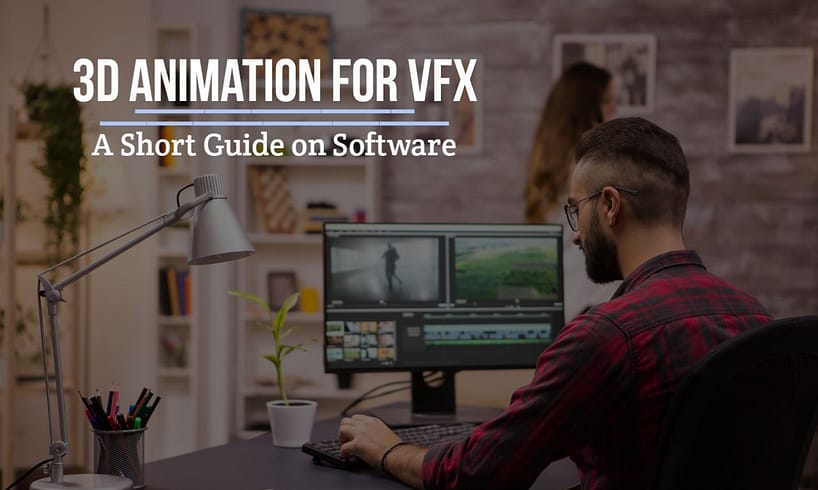
Animation as an industry has changed the course of history and cinema forever. What was once only subtle 2D animation made for children and entertainment is being used extensively today in movies, businesses, manufacturing, and practically anywhere. Focusing on the film industry, 3D animation is the primary asset that has enabled the unimaginable and the unreal to be very real.
A 3D animator in the VFS industry can make and create almost anything. From characters, weapons, tools, background items like buildings, bridges, and even dust, hair, fur, and any other element. That’s the beauty of 3D – it can create nearly anything.
The Categories of 3D Animation in Visual Effects
3D animation is a vast field with a lot of scope for excelling in nearly anything. But, the reality of things is that though there is a lot of scope in the field, individuals like to niche themselves due to the complexities of the software that are associated with the animation process. While some are asset builders, others specialize in particle animation or fur animation, there are even animators in the industry who solely focus on lighting animation. In VFX, to make the impossible come to life, such niche skills are a requirement.
Some of the specializations that 3D animators can opt for in the Visual Effects industry include:
Particle Simulation Animation
In the visual effects industry, particle animation is any effect that involvement of particle simulators. The rain, snow, dust, tornado, a swarm of bees, and anything that is considered to be a part of mass animation is achieved through particle animation. Using a particle simulator reduces the excess time that animators would take to sit and animate each element separately.
Particle animators are great at simulating different weather phenomena in VFX. Clubbed with the expertise of the lighting artist, they make a scene come to life and make it look as blended as possible.
Fluid Simulation
Fluids have dynamics of their own. Though considered to be a part of particle animation, the added element of the viscosity of liquids along with the physics that are governing it comes to play. Fluid animation like the animation of waves, fire, smoke, etc, all fall under this dynamic branch of 3D animation.
Fluid simulation is extremely intricate work in the VFX industry. There is an ongoing need for the fluid simulation to look as real as possible to blend with the context of movies.
Hair & Fur Simulation
One of the most difficult jobs in the VFX industry is the recreation and rendering of hair and fur. Unlike liquids or particle animation, hair and fur have dynamics of their own that do not follow common laws. The simulation and recreation of these are therefore all the more difficult.
Hair and fur are primarily affected by gravity and environmental conditions. A hair and fur simulation, therefore, requires proper expertise and understanding of all the elements that go into the making and recreation of these elements.
In the VFX industry, those 3D artists that can effectively simulate hair and fur are in high demand for their expertise on the subject of recreating difficult three-dimensional elements.
What are the Most Used Softwares for 3D Animation?
3D animation, unlike 2D animation, cannot be created with the help of a pen and paper only. There is a requirement for a space where there are three axes i.e. X, Y, and Z access to make 3D animation possible
Taking a survey from some of the best VFX studios in Pune, the top three 3D animation software that are used in the industry include:
Blender
Blender is widely regarded as one of the best software programs available in the industry. Being open-source software, anyone can download this software and start learning 3D animation. In addition to having a very user-friendly interface, the software comes with some powerful rendering tools that make it easier to practice and simulate 3D elements.
Autodesk Maya
Autodesk Maya is one of the tools that is known to be an all-rounder for the animation and VFX industries. Using this software, one can not only create particle animations and simulations of different types but also a variety of assets not only for movies but for games and other industries.
The best thing about Autodesk Maya is that regular updates and upgrades are performed on the software. In addition, there are also features where an animator can customize the user interface to their advantage. It is user-friendly software that is standardized across industries.
Cinema 4D
Cinema 4D is notorious for being an animator’s favorite software for animation. This is because of the interface and the sheer speed that the software has in terms of getting things done. In comparison to all other software on the market, Cinema 4D is faster at creating assets, animations, and rendering.
In addition to being extremely user-friendly, the software comes with in-built guides to help animators create the best possible output for their designs and animation. This software is mostly used for VFX and the film industry to simulate different animations in different environments.
What’s Rendering?
At the end of the day, a movie or TV series is seen on a two-dimensional screen. Irrespective of how advanced the 3D animation and the assets that are on the screen, they all have to be converted to fit on a two-dimensional screen. In simple terms, the process of converting a three-dimensional image or animation into the perspective of two dimensions is known as “rendering.”
Usually, 3D animation or elements are put into perspective. They are also given the appropriate lighting, and the settings are set to render the scene according to the requirements of the director or producer. Rendering is a long process since every element of a scene has to be imprinted into a 2D frame. In 3D animation, no scene or animation is complete without the process of rendering the scene. It is one of the most important and final processes that go into making an animation come to life.
In Conclusion
3D animation is a complex and fascinating process. From knowing the software that is involved in making a 3D animation or asset to knowing how to render an image properly, several complex processes are involved in making a scene as perfect as possible.
Thus, 3D animators’ complexities and skill sets are what keep them in high demand in the VFX and film industries. Making the unreal come to life and creating near-impossible animations are all thanks to the skills and expertise of animators.
3D animation for movies is expected to only grow and cross more boundaries in the near future.






